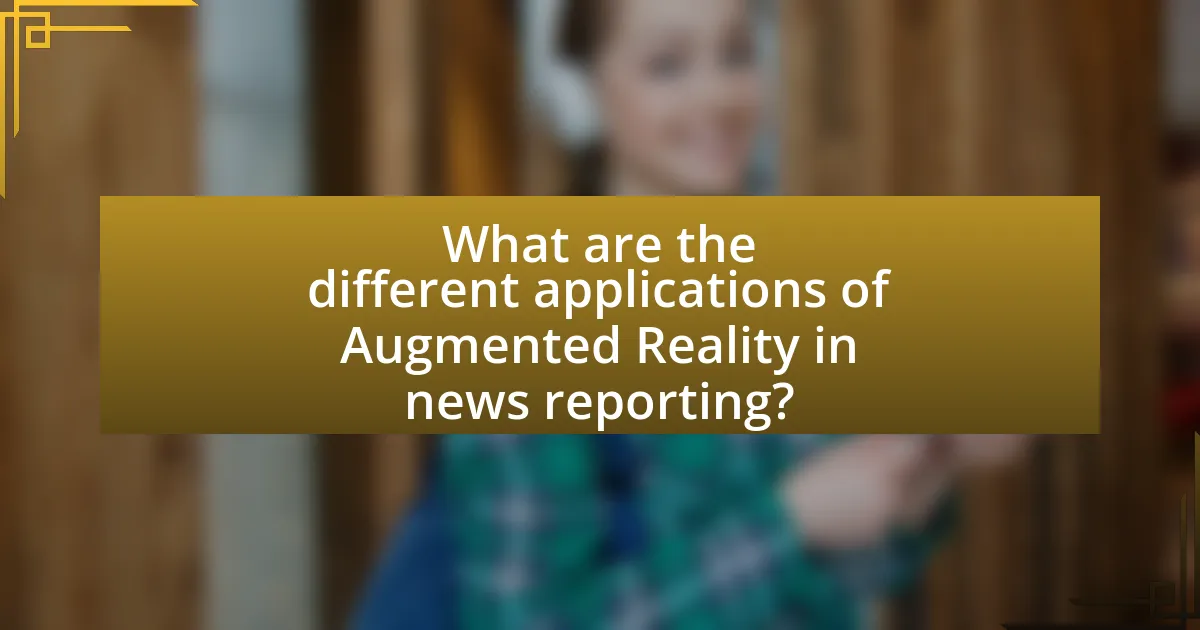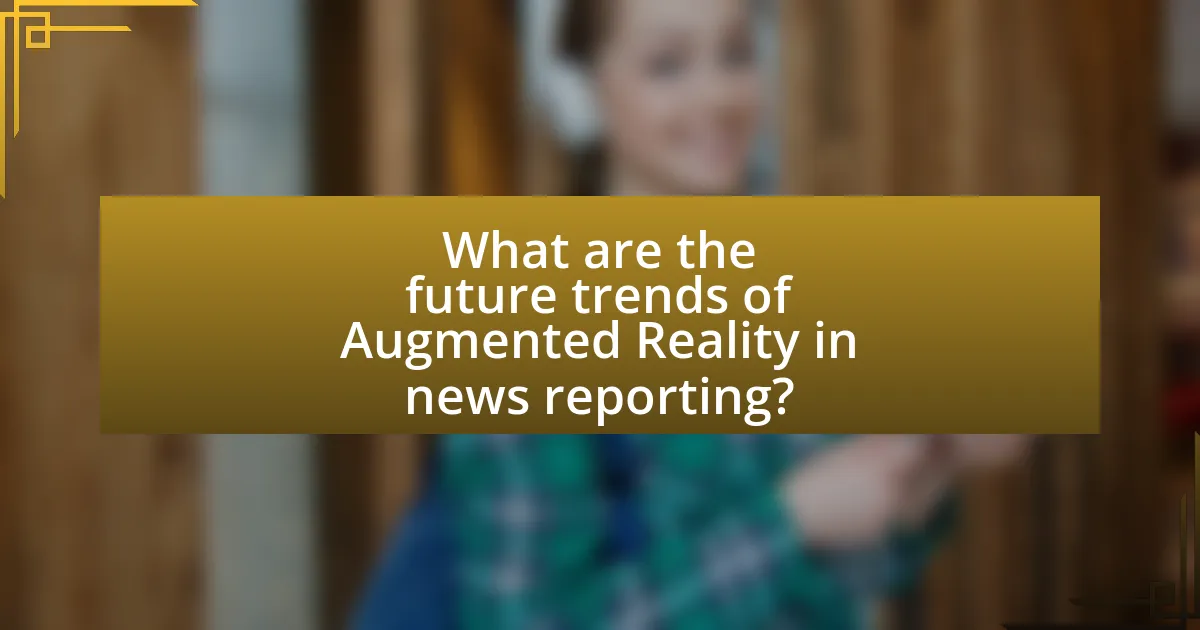The article analyzes the role of Augmented Reality (AR) in news reporting, highlighting its ability to enhance audience engagement through immersive and interactive experiences. It discusses how AR allows news organizations to overlay digital information onto the real world, facilitating the visualization of complex data and improving viewer comprehension. Key technologies involved in AR implementation, such as computer vision and AR software development kits, are examined, along with the challenges traditional news reporting faces that AR addresses. The article also explores the future trends of AR in journalism, emphasizing the importance of user experience and content relevance for successful integration.

What is the Role of Augmented Reality in News Reporting?
Augmented Reality (AR) enhances news reporting by providing immersive experiences that engage audiences more effectively. AR allows news organizations to overlay digital information onto the real world, enabling viewers to visualize complex data, such as statistics or geographical information, in a more intuitive manner. For instance, during live broadcasts, AR can illustrate weather patterns or display interactive maps, making the information more accessible and understandable. This technology has been adopted by major news outlets, such as CNN and The New York Times, which have utilized AR to create interactive storytelling experiences that captivate viewers and enhance their understanding of news events.
How does Augmented Reality enhance the news reporting experience?
Augmented Reality (AR) enhances the news reporting experience by providing immersive and interactive content that engages viewers more effectively than traditional media. AR allows news organizations to overlay digital information onto the real world, enabling audiences to visualize complex data, such as statistics or geographical information, in a more intuitive manner. For instance, during live broadcasts, AR can display real-time graphics that illustrate weather patterns or election results, making the information more accessible and understandable. Studies have shown that interactive elements in news reporting can increase viewer retention and comprehension, as audiences are more likely to engage with content that allows them to explore and interact with the information presented.
What technologies are involved in implementing Augmented Reality in news?
The technologies involved in implementing Augmented Reality (AR) in news include computer vision, depth tracking, and AR software development kits (SDKs). Computer vision enables devices to interpret and understand visual information from the real world, allowing for the overlay of digital content on physical environments. Depth tracking technology helps in accurately placing virtual objects in a three-dimensional space, ensuring they interact realistically with the real world. AR SDKs, such as ARKit and ARCore, provide developers with the tools necessary to create AR applications, facilitating the integration of AR experiences into news content. These technologies collectively enhance storytelling by providing immersive and interactive experiences for viewers.
How does Augmented Reality change audience engagement in news reporting?
Augmented Reality (AR) enhances audience engagement in news reporting by providing immersive and interactive experiences that allow viewers to visualize complex information in real-time. This technology enables news organizations to present stories with 3D graphics, animations, and contextual data overlays, making the content more relatable and easier to understand. For instance, a study by the Pew Research Center found that audiences are more likely to retain information when it is presented through interactive formats, as AR can transform static news into dynamic narratives that capture attention and stimulate interest.
Why is Augmented Reality becoming important in modern journalism?
Augmented Reality (AR) is becoming important in modern journalism because it enhances storytelling by providing immersive experiences that engage audiences more effectively. This technology allows journalists to overlay digital information onto the real world, enabling viewers to interact with news content in a more dynamic way. For instance, AR can visualize complex data, such as statistics or geographical information, making it easier for audiences to understand critical issues. A study by the Pew Research Center found that 70% of news consumers are more likely to engage with content that includes interactive elements, highlighting the effectiveness of AR in capturing attention and improving information retention.
What challenges does traditional news reporting face that AR addresses?
Traditional news reporting faces challenges such as limited engagement, lack of interactivity, and difficulty in conveying complex information, which augmented reality (AR) effectively addresses. AR enhances viewer engagement by providing immersive experiences that allow audiences to interact with news content in real-time. For instance, AR can visualize data and statistics in a more digestible format, making complex stories easier to understand. Additionally, AR can create a more dynamic storytelling environment, allowing viewers to explore news stories from multiple angles, thereby increasing retention and comprehension. This innovative approach has been shown to improve audience interaction, as evidenced by studies indicating that AR can increase viewer interest and information retention by up to 70%.
How does AR improve the storytelling aspect of news reporting?
Augmented Reality (AR) enhances the storytelling aspect of news reporting by providing immersive experiences that engage viewers more deeply. This technology allows news organizations to overlay digital information onto the real world, enabling audiences to visualize complex stories, such as natural disasters or political events, in a more interactive manner. For instance, AR can illustrate the impact of a hurricane by displaying real-time data on affected areas, making the information more relatable and easier to understand. Studies have shown that immersive storytelling through AR can increase viewer retention and emotional connection to the news, as it transforms passive consumption into an active experience.

What are the different applications of Augmented Reality in news reporting?
Augmented Reality (AR) in news reporting has several applications, including immersive storytelling, real-time data visualization, and enhanced viewer engagement. Immersive storytelling allows audiences to experience news events as if they are present, using AR to overlay digital content onto the real world. Real-time data visualization enables journalists to present complex information, such as statistics or geographical data, in an easily digestible format, enhancing understanding. Enhanced viewer engagement is achieved through interactive elements that allow users to explore news stories in depth, fostering a more participatory experience. These applications are increasingly utilized by news organizations to create more compelling and informative content.
How is Augmented Reality used in live news broadcasts?
Augmented Reality (AR) is used in live news broadcasts to enhance viewer engagement and provide real-time information overlays. News organizations utilize AR technology to display graphics, statistics, and 3D models that complement the on-screen reporting, making complex information more accessible. For instance, during weather reports, AR can visualize storm paths or temperature changes directly on the screen, allowing viewers to better understand the data being presented. This application of AR has been shown to increase audience retention and comprehension, as evidenced by studies indicating that interactive visuals can improve information recall by up to 65%.
What are some examples of successful AR implementations in live news?
Successful AR implementations in live news include CNN’s use of AR during the 2020 presidential election coverage, where they displayed interactive graphics and data visualizations to enhance viewer engagement. Another example is the BBC’s AR integration during the 2019 general election, which allowed viewers to see real-time election results and candidate information in an immersive format. Additionally, Sky News utilized AR to present weather forecasts and sports highlights, providing a more dynamic viewing experience. These implementations demonstrate how AR can effectively enhance storytelling and viewer interaction in live news broadcasts.
How does AR contribute to real-time information delivery in news?
Augmented Reality (AR) enhances real-time information delivery in news by overlaying digital content onto the physical world, allowing viewers to engage with live data and visuals. This technology enables journalists to present complex information, such as statistics or geographical data, in an interactive format that can be updated instantaneously during broadcasts or online reporting. For instance, AR can display live weather updates or real-time sports statistics directly on the screen, providing audiences with immediate context and enhancing their understanding of the news. Studies have shown that AR increases viewer engagement and retention of information, making it a powerful tool for modern news reporting.
What role does Augmented Reality play in investigative journalism?
Augmented Reality (AR) enhances investigative journalism by providing immersive storytelling experiences that allow audiences to engage with complex information visually. AR enables journalists to overlay digital content onto the real world, facilitating a deeper understanding of investigative findings, such as crime scenes or historical events. For instance, The New York Times utilized AR in its reporting on the 2017 Las Vegas shooting, allowing readers to visualize the scene and comprehend the scale of the tragedy. This application of AR not only enriches the narrative but also aids in presenting data and evidence in a more accessible format, thereby improving audience engagement and comprehension.
How can AR visualize complex data for investigative reports?
Augmented Reality (AR) can visualize complex data for investigative reports by overlaying digital information onto the physical world, allowing users to interact with data in a more intuitive manner. This technology enables journalists to present intricate datasets, such as crime statistics or financial records, in a visually engaging format that enhances understanding. For instance, AR can transform static graphs into 3D models, enabling viewers to explore data from various angles, thereby revealing patterns and insights that may not be immediately apparent in traditional formats. Studies have shown that visualizing data through AR can improve retention and comprehension, making it a powerful tool for investigative reporting.
What are the ethical considerations when using AR in investigative journalism?
The ethical considerations when using augmented reality (AR) in investigative journalism include issues of accuracy, consent, and potential misinformation. Accuracy is crucial, as AR can distort reality or present information in misleading ways, which may misinform the audience. Consent is another significant factor; journalists must ensure that individuals depicted in AR content have given permission for their likenesses to be used, respecting privacy rights. Additionally, the potential for misinformation arises when AR overlays are not clearly labeled as such, leading audiences to confuse augmented elements with factual reporting. These considerations are essential to maintain journalistic integrity and uphold ethical standards in reporting.

What are the future trends of Augmented Reality in news reporting?
The future trends of Augmented Reality (AR) in news reporting include enhanced interactivity, immersive storytelling, and real-time data visualization. News organizations are increasingly adopting AR to create engaging experiences that allow audiences to interact with content, such as viewing 3D models of news events or exploring interactive infographics. For instance, a study by the Reuters Institute for the Study of Journalism highlights that 60% of journalists believe AR will play a significant role in the future of news delivery. Additionally, AR can provide real-time updates and contextual information, enriching the viewer’s understanding of complex stories. As technology advances, the integration of AR with artificial intelligence will further personalize news experiences, tailoring content to individual preferences and enhancing user engagement.
How might Augmented Reality evolve in the next decade for news media?
Augmented Reality (AR) is expected to significantly enhance news media by providing immersive storytelling experiences over the next decade. This evolution will likely include the integration of real-time data overlays during live broadcasts, allowing viewers to interact with news content in a more engaging manner. For instance, AR can visualize complex data, such as election results or climate change statistics, directly in the viewer’s environment, making information more accessible and understandable.
Furthermore, advancements in AR technology, such as improved mobile devices and faster internet connectivity, will facilitate the widespread adoption of AR applications in news reporting. According to a 2022 report by the Pew Research Center, 60% of news organizations are exploring AR to enhance audience engagement, indicating a strong trend towards this technology in the industry. As AR tools become more user-friendly and cost-effective, news outlets will likely leverage them to create personalized news experiences, allowing users to customize the information they receive based on their interests.
What innovations are on the horizon for AR technology in journalism?
Innovations on the horizon for AR technology in journalism include enhanced interactive storytelling, real-time data visualization, and immersive news experiences. These advancements aim to engage audiences more deeply by allowing them to interact with news content in a three-dimensional space. For instance, AR can enable viewers to visualize complex data sets or historical events in their real-world environment, making the information more accessible and impactful. Research from the Reuters Institute for the Study of Journalism indicates that 60% of journalists believe AR will play a significant role in the future of news reporting, highlighting its potential to transform how stories are told and consumed.
How can news organizations prepare for the future of AR in reporting?
News organizations can prepare for the future of augmented reality (AR) in reporting by investing in AR technology and training their staff to effectively use it. By adopting AR tools, news organizations can enhance storytelling through immersive experiences that engage audiences more deeply. For instance, a study by the Pew Research Center indicates that 72% of journalists believe AR can improve audience engagement, highlighting its potential impact. Additionally, developing partnerships with tech companies specializing in AR can provide news organizations with the necessary resources and expertise to implement AR solutions effectively.
What best practices should news organizations follow when implementing Augmented Reality?
News organizations should prioritize user experience, content relevance, and technical reliability when implementing Augmented Reality (AR). Focusing on user experience ensures that AR features are intuitive and enhance storytelling without overwhelming the audience. Content relevance is crucial; AR should complement the news narrative, providing additional context or engagement rather than serving as a gimmick. Technical reliability is essential to avoid glitches that can detract from the credibility of the news organization. According to a study by the Pew Research Center, 72% of users prefer news that is interactive and engaging, highlighting the importance of these best practices in fostering audience connection and trust.
How can newsrooms effectively train staff to use AR tools?
Newsrooms can effectively train staff to use AR tools by implementing structured training programs that include hands-on workshops, online courses, and collaborative projects. These training programs should focus on practical applications of AR in news reporting, allowing staff to engage with the technology directly. For instance, a study by the Pew Research Center found that immersive training experiences significantly enhance learning outcomes, suggesting that interactive sessions can improve staff proficiency with AR tools. Additionally, providing ongoing support and resources, such as access to AR software and expert consultations, can further reinforce skills and encourage innovation in storytelling.
What are the key factors for successful AR integration in news reporting?
The key factors for successful AR integration in news reporting include user engagement, content relevance, technological accessibility, and seamless user experience. User engagement is crucial as AR enhances storytelling by providing interactive elements that capture audience attention. Content relevance ensures that the AR features complement the news story, making the information more digestible and impactful. Technological accessibility is important, as the AR experience must be compatible with widely used devices to reach a broader audience. Lastly, a seamless user experience is vital; if the AR integration is clunky or difficult to navigate, it can detract from the overall effectiveness of the news report. These factors collectively contribute to the successful implementation of AR in news reporting, as evidenced by various case studies demonstrating increased viewer retention and satisfaction when AR is effectively utilized.

Leave a Reply